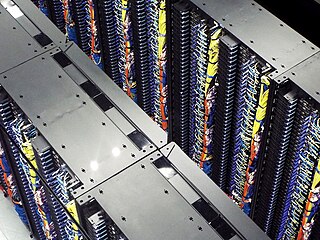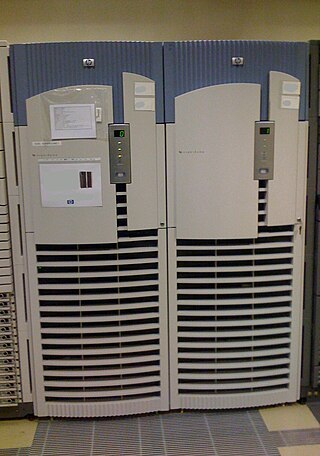
Itanium is a discontinued family of 64-bit Intel microprocessors that implement the Intel Itanium architecture. The Itanium architecture originated at Hewlett-Packard (HP), and was later jointly developed by HP and Intel. Launched in June 2001, Intel initially marketed the processors for enterprise servers and high-performance computing systems. In the concept phase, engineers said "we could run circles around PowerPC...we could kill the x86." Early predictions were that IA-64 would expand to the lower-end servers, supplanting Xeon, and eventually penetrate into the personal computers, eventually to supplant reduced instruction set computing (RISC) and complex instruction set computing (CISC) architectures for all general-purpose applications.

Blue Gene was an IBM project aimed at designing supercomputers that can reach operating speeds in the petaFLOPS (PFLOPS) range, with low power consumption.

Columbia was a supercomputer built by Silicon Graphics (SGI) for the National Aeronautics and Space Administration (NASA), installed in 2004 at the NASA Advanced Supercomputing (NAS) facility located at Moffett Field in California. Named in honor of the crew who died in the Space Shuttle Columbia disaster, it increased NASA's supercomputing capacity ten-fold for the agency's science, aeronautics and exploration programs.

MareNostrum is the main supercomputer in the Barcelona Supercomputing Center. It is the most powerful supercomputer in Spain, one of thirteen supercomputers in the Spanish Supercomputing Network and one of the seven supercomputers of the European infrastructure PRACE.
HPE Integrity Servers is a series of server computers produced by Hewlett Packard Enterprise since 2003, based on the Itanium processor. The Integrity brand name was inherited by HP from Tandem Computers via Compaq.

Roadrunner was a supercomputer built by IBM for the Los Alamos National Laboratory in New Mexico, USA. The US$100-million Roadrunner was designed for a peak performance of 1.7 petaflops. It achieved 1.026 petaflops on May 25, 2008, to become the world's first TOP500 LINPACK sustained 1.0 petaflops system.

Magerit is one of the most powerful supercomputers in Spain. It also reached the second best Spanish position in the TOP500 list of supercomputers. It is installed in CeSViMa, a research center of the Technical University of Madrid.

The Spanish Supercomputing Network (RES) is a distributed infrastructure involving the interconnexion of 12 supercomputers which work together to offer High Performance Computing resources to the scientific community. It is coordinated by the Barcelona Supercomputing Center (BSC).

The HPE Superdome is a high-end server computer designed and manufactured by Hewlett Packard Enterprise. The product's most recent version, "Superdome 2," was released in 2010 supporting 2 to 32 sockets and 4 TB of memory. The Superdome used PA-RISC processors when it debuted in 2000. Since 2002, a second version of the machine based on Itanium 2 processors has been marketed as the HP Integrity Superdome.

Centro de Supercomputación de Galicia (CESGA) is a high performance computing center in Galicia (Spain). Its most important features are the supercomputer FinisTerrae and the "Superordenador Virtual Gallego". Finisterrae is nowadays the third most powerful supercomputer in Spain, and it was initially ranked 100th according to the Top500 when installed in November 2007. CESGA provides advanced computing services to the Galician Scientific Community, Galician Universities and to the Spanish National Research Council.

IBM Sequoia was a petascale Blue Gene/Q supercomputer constructed by IBM for the National Nuclear Security Administration as part of the Advanced Simulation and Computing Program (ASC). It was delivered to the Lawrence Livermore National Laboratory (LLNL) in 2011 and was fully deployed in June 2012. Sequoia was dismantled in 2020, its last position on the top500.org list was #22 in the November 2019 list.
The National Center for Computational Sciences (NCCS) is a United States Department of Energy (DOE) Leadership Computing Facility that houses the Oak Ridge Leadership Computing Facility (OLCF), a DOE Office of Science User Facility charged with helping researchers solve challenging scientific problems of global interest with a combination of leading high-performance computing (HPC) resources and international expertise in scientific computing.

Jaguar or OLCF-2 was a petascale supercomputer built by Cray at Oak Ridge National Laboratory (ORNL) in Oak Ridge, Tennessee. The massively parallel Jaguar had a peak performance of just over 1,750 teraFLOPS. It had 224,256 x86-based AMD Opteron processor cores, and operated with a version of Linux called the Cray Linux Environment. Jaguar was a Cray XT5 system, a development from the Cray XT4 supercomputer.

The National Computational Infrastructure is a high-performance computing and data services facility, located at the Australian National University (ANU) in Canberra, Australian Capital Territory. The NCI is supported by the Australian Government's National Collaborative Research Infrastructure Strategy (NCRIS), with operational funding provided through a formal collaboration incorporating CSIRO, the Bureau of Meteorology, the Australian National University, Geoscience Australia, the Australian Research Council, and a number of research-intensive universities and medical research institutes.

Several centers for supercomputing exist across Europe, and distributed access to them is coordinated by European initiatives to facilitate high-performance computing. One such initiative, the HPC Europa project, fits within the Distributed European Infrastructure for Supercomputing Applications (DEISA), which was formed in 2002 as a consortium of eleven supercomputing centers from seven European countries. Operating within the CORDIS framework, HPC Europa aims to provide access to supercomputers across Europe.

The high performance supercomputing program started in mid-to-late 1980s in Pakistan. Supercomputing is a recent area of Computer science in which Pakistan has made progress, driven in part by the growth of the information technology age in the country. Developing on the ingenious supercomputer program started in 1980s when the deployment of the Cray supercomputers was initially denied.
XK7 is a supercomputing platform, produced by Cray, launched on October 29, 2012. XK7 is the second platform from Cray to use a combination of central processing units ("CPUs") and graphical processing units ("GPUs") for computing; the hybrid architecture requires a different approach to programming to that of CPU-only supercomputers. Laboratories that host XK7 machines host workshops to train researchers in the new programming languages needed for XK7 machines. The platform is used in Titan, the world's second fastest supercomputer in the November 2013 list as ranked by the TOP500 organization. Other customers include the Swiss National Supercomputing Centre which has a 272 node machine and Blue Waters has a machine that has Cray XE6 and XK7 nodes that performs at approximately 1 petaFLOPS (1015 floating-point operations per second).

Summit or OLCF-4 is a supercomputer developed by IBM for use at Oak Ridge Leadership Computing Facility (OLCF), a facility at the Oak Ridge National Laboratory, United States of America. As of June 2024, it is the 9th fastest supercomputer in the world on the TOP500 list. It held the number 1 position on this list from November 2018 to June 2020. Its current LINPACK benchmark is clocked at 148.6 petaFLOPS.
The Holland Computing Center, often abbreviated HCC, is the high-performance computing core for the University of Nebraska System. HCC has locations in both the University of Nebraska-Lincoln June and Paul Schorr III Center for Computer Science & Engineering and the University of Nebraska Omaha Peter Kiewit Institute. The center was named after Omaha businessman Richard Holland who donated considerably to the university for the project.
The Sunway TaihuLight is a Chinese supercomputer which, as of November 2023, is ranked 11th in the TOP500 list, with a LINPACK benchmark rating of 93 petaflops. The name is translated as divine power, the light of Taihu Lake. This is nearly three times as fast as the previous Tianhe-2, which ran at 34 petaflops. As of June 2017, it is ranked as the 16th most energy-efficient supercomputer in the Green500, with an efficiency of 6.1 GFlops/watt. It was designed by the National Research Center of Parallel Computer Engineering & Technology (NRCPC) and is located at the National Supercomputing Center in Wuxi in the city of Wuxi, in Jiangsu province, China.





















